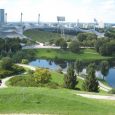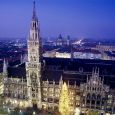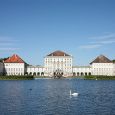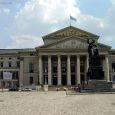Munich
Advertisement
By Air
The Munich International Airport (MUC) is Germany’s second largest international airport after Frankfurt and the eighth largest in Europe. Since its opening in 1992, there have been more than 500 flights arriving and departing each day. From the UK, British Airways, Lufthansa and British Midland offer regularly scheduled services.
From other international airports, direct flights to Munich are almost exclusively with Lufthansa. For example, most other airlines flying to Munich from North America require a connection at Frankfurt, Dusseldorf or another gateway.
By Bus
You can travel by bus to Munich from London, Paris and many other European cities. The largest bus operator from the UK to the continent is Eurolines operating out of London’s centrally located Victoria Coach Station. In Paris, Eurolines is located on rue Malmaison, a 35-minute Metro ride from the centre. In Munich, bus services usually terminate at the Zentraler Busbahnhof, which you will find on the north side of the Hauptbahnhof.
By Rail
All trains entering Munich come in to the city’s centrally-located main station (Hauptbahnhof), which is shared by the city's rail and bus systems, providing connections to all destinations within the city and around the region. High-speed InterCity Express (ICE) trains from Hamburg, Frankfurt and Augsburg provide rapid service to Munich. The City Nightline (CNL) features comfortable sleeping quarters on its overnight services. The Deutsche Bahn has more than 25,000 miles of track, connecting all points in Germany, with international service as well.
By car
Munich is very accessible by car from all directions on the continent, by Germany’s autobahn system. The A8 from Stuttgart and Augsburg enters Munich from the northwest, continuing in a southeasterly direction to Salzburg. The A9 comes into Munich from the north, originating in Berlin. The A92 and A3 begin in Passau and enter Munich from the east. The A95 comes in from the southwest, having originated in Garmisch.
Bavarian State Opera House
The National Theater, Munich's world-famous opera house, originally known as the Königliches Hof und Nationaltheater (Royal Court and National Theater), was Commissioned by King Max I Joseph and built by Karl von Fischer in Neo-Classical style in 1811-18. Burned down in 1823, it reopened in 1825. It was destroyed again during the Second World War, when the Opera moved to the Prinzregententheater, but was rebuilt in its original form and reopened in 1963. Several more years of renovation were completed in 1988.
The portico with its Corinthian columns and the two triangular pediments are reminiscent of a Greek temple. In the pediment of the portico itself are Apollo and the Muses (by Brenninger, 1972), in the pediment of the tall main structure a colored glass mosaic on a gold ground depicting Pegasus with the Horae (by Ludwig Schwanthaler). The interior is also predominantly Greek in style - the entrance lobby Doric, the staircase Ionic, the Royal Foyer Corinthian. The auditorium with its five tiers of seating is decorated in red, ivory, dove-blue and gold.
Olympia Park
Munich's huge Olympic park complex was built in 1972 for the 20th Olympic Games, and it still attracts visitors today. The main stadium, in the shape of a gigantic tent, can seat 70,000 spectators. It is covered by 720,000 square feet of tinted acrylic glass, creating the largest roof in the world. The roof was constructed to collect rainwater, which keeps the adjacent Olympic lake filled. An observation deck and revolving restaurant atop the 950 foot Olympic Tower provide visitors with a spectacular view. The BMW Museum, near the Tower, features the history of this famous German car manufacturer. The park is a vital part of Munich life, as on more than 200 days each year, it is home to concerts, sporting events, trade fairs and exhibitions.
Nymphenburg Palace
From Munich’s centre, Schloss Nymphenburg is a short bus or tram ride away. It was originally the summer home of Munich royalty, and has been significantly enlarged and embellished by various owners since the original construction commenced in 1664. Today, tourists enjoy exploring the villa and its grounds. Inside, there are interesting frescoes in the main hall and also an arcaded gallery with a collection of provocative paintings commissioned by King Ludwig I, depicting the most beautiful women of the day. In the grounds surrounding the villa, there are several pavilions hidden in the English-style gardens. Many of King Ludwig’s elaborate coaches are on display, and there is also a porcelain museum of interest here.
Hellabrunn Zoo
pread over some 36ha/89 acres at Hellabrunn, Munich's zoo is one of the most popular attractions in Bavaria. When it was laid out in 1928 it was the world's first geographically organized zoo. Grouped according to the different parts of the globe from which they come, more than 4,000 of the world's most interesting animals are held in open enclosures reproducing as far as possible conditions in the wild. Landscape and architecture harmonize to a degree rarely achieved. Species which normally share habitats are kept together wherever possible (e.g. chamois and marmots).
Such popular features as the Elephant House (now a listed building), the enormous 5,000sq.m/6,000sq.yd covered free-flight aviary, the polarium and the ape houses, which are among the highlights of the zoo, have been enlarged and improved in the last few years at considerable expense.
Hellabrunn Zoo is situated on a lower terrace of the Isar, now a designated nature conservation area. In the case of enclosures recently refurbished, railings have been kept to a minimum. Delightful footpaths, children's playgrounds, eating and picnic places, contribute to making the zoo a recreational oasis.
German Museum
The German Museum for Master-Works of Science and Technology in Munich is the world's largest museum of technology, covering an area of more than 50,000sq.m/59,800sq.yd and displaying some 17,000 exhibits. The collections are constantly being expanded by the addition of the latest technological developments.
The museum was founded in 1903 and directed in its early years by Oskar von Miller. Since 1925 it has been housed in a large complex built by Gabriel von Seidl on an island in the Isar, later supplemented by a library, conference hall and other such extensions.
The original conference hall, now housing the Forum der Technik which always attracts crowds of visitors, was for decades one of Munich's principal venues. It was here that the Christian Socialist Union (CSU) was founded in November 1945 and the German trade union federation was formed in 1949. Many well-known artists also appeared at the hall.
New Town Hall
In the mid 19th C the Munich Municipal Council resolved to build a new Town Hall to provide much-needed additional office space. A site was cleared by the demolition of 24 older buildings, including the hall in which the Bavarian Estates had met from 1554 to 1807, and a new building was designed by Georg Hauberisser. It was erected in three stages - first the brick-built eastern part (1867-74), then the extension to the rear (1889-92), and finally the western half, in limestone, with the 85m/280ft-high tower, which vies with the towers of the Frauenkirche as Munich's best-known landmark.
The main front, looking onto the Marienplatz, is decorated with a profusion of figures and ornaments - Bavarian dukes, electors and kings, fabulous creatures, saints, Munich types and characters.
Marien Square
Marienplatz has been Munich's central square since the foundation of the town. For many centuries, until 1807, it was the market square, and during the Middle Ages it was frequently the venue of knightly tournaments. The present buildings date mainly from the 19th and 20th C.
The dominant feature of the square is the New Town Hall (Neues Rathaus), a building of overpowering proportions which occupies the whole of the north side. At the east end of the square stands the Old Town Hall (Altes Rathaus), with its reconstructed tower. The massive modern department store at the southwest corner is one of the most controversial of the new buildings in Munich's Old Town
Information not available






